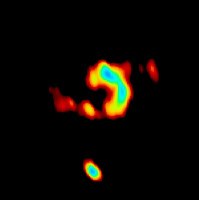GMRT discovery of young supernova remnant
A new and one of the youngest supernova remnant within our Galaxy has been discovered using the Giant Metrewave Radio Telescope (GMRT), near Pune, by two young scientists Dr. Subhashis Roy of NCRA, Pune and Dr. Sabyasachi Pal of ICSP, Kolkatta. This was a prized catch during their search programme to look for new Supernova remnants towards the center of our Galaxy. Established theories of formation and evolution of stars in our Galaxy predict that one star dies due to Supernova explosions once every 35 years. Stars which are much more heavier than our Sun, die by the phenomenon know as Supernova Explosion. Such explosions can be seen through naked eye or by small telescopes for first few days and fade rapidly thereafter. Subsequently, they start emitting in the radio frequency band, and the radiation originates from the high-speed ejecta, expanding in a shell-like structure, with a speed of thousands of kilometers per second. Such shells will be of smaller size for new Supernova remnants and will eventually fade away for very old ones. About thousand Supernova remnants are expected to be have in our Galaxy, but only about 270 are discovered so far. In the recent 400 years, about a dozen supernovas should have taken place, but only two of them have been discovered till date. Various groups across the world are trying to find more Supernova remnants. Major reason for not discovering the expected number of supernova remnants is lack of telescopes which can search with better sensitivity and resolution. The GMRT makes this possible.
In a project undertaken by Dr. Subhashis Roy of National Centre for Radio Astrophysics, Pune and Dr. Sabyasachi Pal of Indian Centre for Space Physics, Kolkatta, to search for new Supernova remnants, they have discovered a small sized supernova remnant in our Galaxy near the center using the GMRT, due to its superior resolution and sensitivity. Detailed age analysis suggested that this supernova should have occurred very recently, not older than a few hundred years, making it one of the youngest supernova remnant discovered with GMRT. This rare discovery raises hopes that in future more Supernova remnants can be discovered if done at optimum resolution and sensitivity, with GMRT.
Their research work is published in the September 2013 issue of the Astrophysical Journal, by the American Astronomical Society.
Contact:
Dr. Subhasis Roy - 09420731869
Dr. Sabyasachi Pal - 09836417804
In the media
- Indians spot rare young supernova - Telegraph, 19 October 2013
- Pune Scientist Discovers Youngest Supernova Remnant - Times of India, October 19, 2013
- Two Indian Scientists Discover Youngest Supernova Remnant- Indian Express, October 19, 2013
Document Actions

